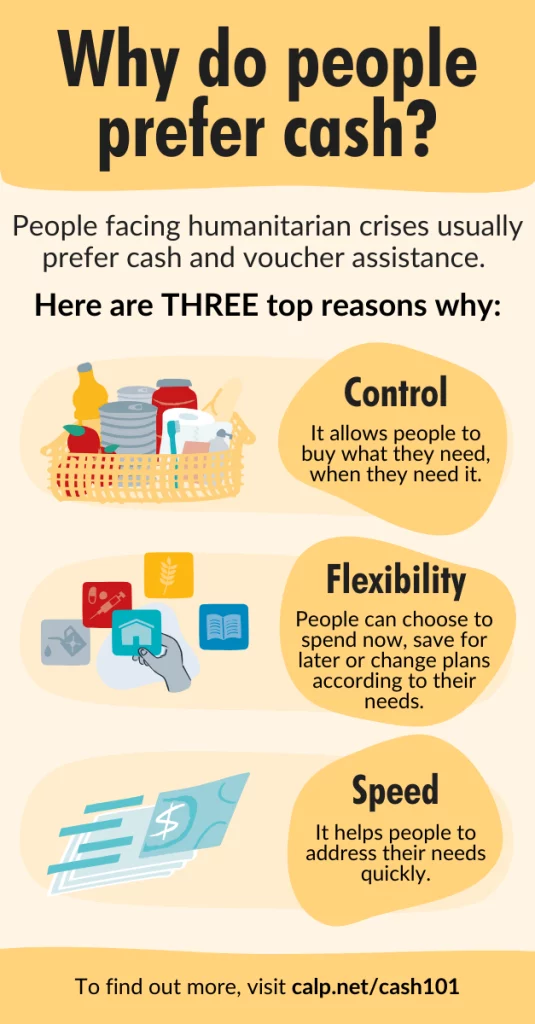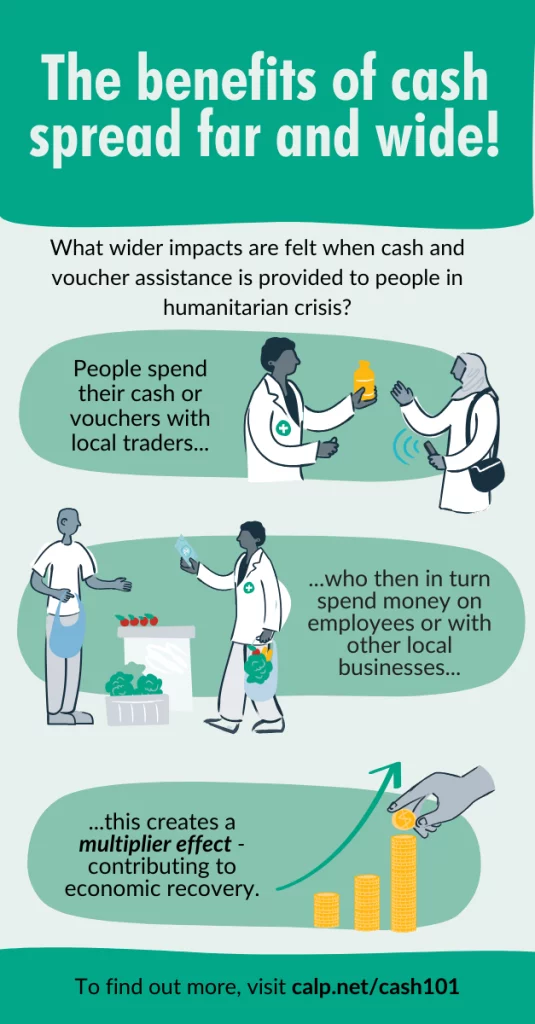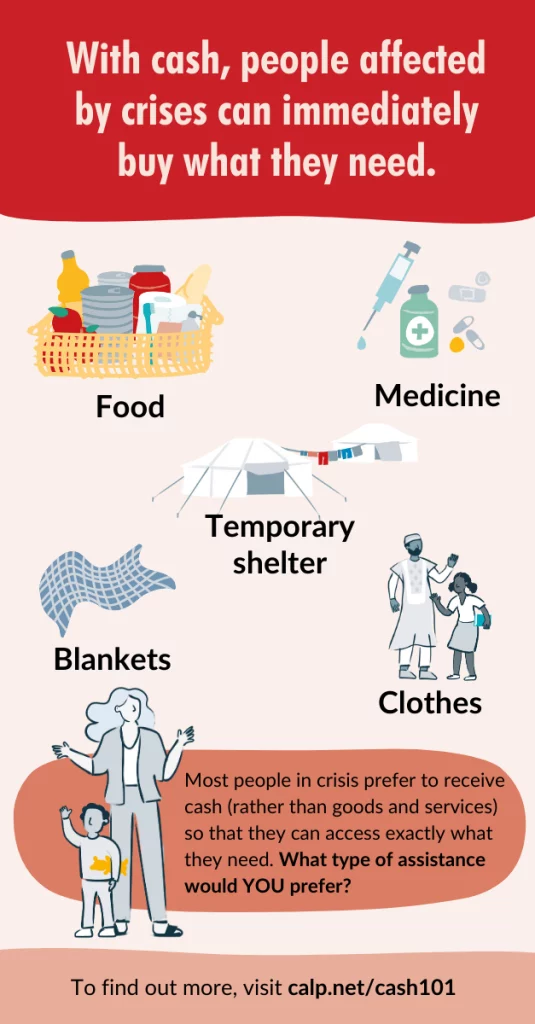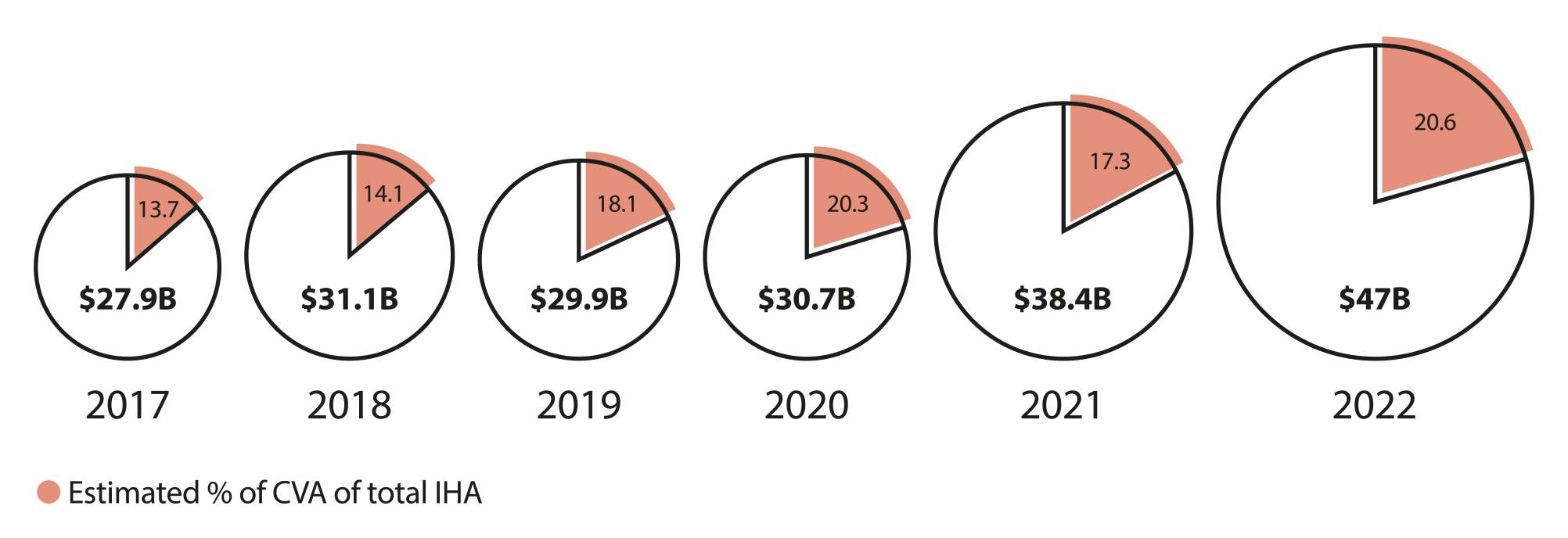What are the benefits of Cash and Voucher Assistance in humanitarian action?

What are the benefits of Cash and Voucher Assistance in humanitarian action?
Cash and Voucher Assistance (CVA) in humanitarian action has several benefits that make it an increasingly popular and effective approach for delivering aid.
Since 2017, CVA as a proportion of humanitarian assistance has increased by 7%, and in 2022 accounted for 20.6% of all international humanitarian assistance.
Some of the major benefits of humanitarian cash and voucher assistance include:
1. Cash and voucher assistance is usually preferred by recipients.
We know that people in crises usually prefer cash and voucher assistance. There is much evidence, but for example, an International Rescue Committee project in Lebanon found 80% of people in crisis preferred cash transfers to in-kind aid. In Yemen key informants reported that between 90% and 100% of households expressed a preference for CVA across surveys, according to the same report, aid recipients in Zimbabwe also confirmed their preference.
What evidence tells us about people's preferences when it comes to humanitarian aid? Swipe through the slides below for references from UNHCR, CALP and UNFPA. pic.twitter.com/uzpPVsqdvk
— CALP Network (@calpnetwork) February 22, 2024
Why is this?
- Control: CVA allows people to decide what they need and when. They can make choices based on their preferences. CVA shifts control from humanitarian agencies, into the hands of people affected by crisis.
- Flexibility: CVA allows people to adapt as their situation and needs change.
- Speed: CVA can allow recipients to promptly address their needs.
While CVA is preferred by most people, individual preferences and circumstances do vary. Preferences and contextual factors should be considered when deciding what type of assistance is appropriate for each response.

2. Cash assistance offers greater dignity and choice.
By providing people with cash or vouchers, they can make choices based on their own priorities, needs and preferences, and have greater agency and control over their own lives. This can promote a greater sense of dignity and choice than other forms of aid.
Cash and vouchers give people the freedom to buy what they need most, whether it be medicine, food, schoolbooks, clothes or many other things.
Cash and voucher assistance enables people in crisis to overcome crises with dignity, according to their own choices and preferences. However this is partly dependent on how the assistance is organised and delivered.
Cash can also reduce queuing times compared to in-kind aid. Older recipients have reported standing in long queues for hours and ending up leaving empty-handed before they get to the front – this causes distress and is undignified. Cash transfers, on the other hand, can be sent directly to mobiles, or delivered to an ATM. In some cases, people may still need to queue for cash or some types of vouchers, but the increasing use of digital transfers reduces this need.
3. CVA is cost-effective
Once systems are established, humanitarian CVA is usually more cost-effective than traditional forms of in-kind aid, such as distributing food or blankets. In 2015, a WFP project in Ethiopia found cash assistance was 25-30% more cost-efficient than food aid.
Why is this?
- One of the main reasons is that people can spend cash on precisely what they need, helping reduce waste. The same is not true of in-kind aid. In many cases, people sell in-kind items that they don’t need, often at a lower cost, wasting aid money. For example, 70% of Syrian refugees in Iraq said they sold their in-kind items to get cash.*
- In-kind aid generally incurs more costs along the supply chain from procuring, sorting, transporting and distributing goods to crisis-affected areas. In contrast, when people in crisis receive cash, they can buy what they need at their local market where costs are usually lower and there is more local produce.
*Vouchers can present the same risk: There are reports of recipients selling vouchers at a lower cost than their face value. For this reason, cash usually presents better value for money than vouchers.
Find out more about the difference between cash, in-kind and vouchers on the Cash 101.
4. Cash benefits the local economy.
Cash and voucher assistance can stimulate and benefit the local economy. People spend their cash or vouchers with local traders, who then in turn spend money on employees or with other local businesses or farmers, contributing to economic recovery. This is often referred to as the “multiplier effect”.
In comparison, distributing goods (such as food and clothes) can harm local businesses by reducing demand for such items.
Several studies have found that every unrestricted dollar of direct cash assistance creates $2 of value in local economies.

CVA can help promote social cohesion between affected populations and host communities. A cash transfer trial in Kenya by GiveDirectly found that grants stimulated the local economy, leading to positive impacts being felt even by people in nearby villages, who reported higher food consumption.
While CVA can benefit the local economy, the conditions might not always be appropriate. For example, if there is a lack of certain goods in the local market, agencies can work with vendors to ensure supplies are available, reducing the risk of price inflation and helping to strengthen the market.
Find out more about CVA Design and Delivery.
5. Cash assistance can help increase financial inclusion.
Humanitarian cash assistance has the potential to increase financial inclusion for people affected by crisis.
- Giving cash transfers supports people to access formal financial services, such as setting up mobile money or bank accounts. For some, this is their first time being included in such systems.
- Once people have access to these formal financial systems, they can take advantage of other financial opportunities, such as opening savings accounts.
- This can lead to further investment in small businesses or assets. In this way, cash can support the transition from humanitarian assistance to longer-term sustainable livelihoods.
While CVA has the potential to increase financial inclusion, it doesn’t happen automatically and involvement in the formal financial system can be temporary.
To maximise the potential for CVA to support financial inclusion, there is a need to recognise and tackle potential barriers, such as the impact of limited infrastructure, digital literacy, or exclusion of marginalised groups. If these barriers are addressed, CVA can support financial inclusion and strengthen economic and social outcomes.
To find out more, visit our CVA and Financial Inclusion page.
6. CVA can contribute to food security, health, shelter and more.
Cash and voucher assistance can have a positive impact on many areas of life for people affected by crisis, such as helping with food, education, health and shelter needs.
- With cash, people can buy food according to their dietary needs, preferences, and local availability. Evidence suggests humanitarian cash transfers support better nutrition and dietary diversity, with recipients less likely to face food insecurity. There is relatively strong evidence that combining household cash transfers with social behaviour change messages can be effective at preventing child malnutrition.
- Cash assistance can help people access healthcare services and medical supplies. If the services are available, CVA can provide access to appropriate and timely medical attention. For example, [unconditional cash transfers] may help cover maternity costs for pregnant women or [conditional cash transfers] may incentivise uptake of immunisation services.
- Humanitarian CVA provides crisis-affected populations with the flexibility to determine their shelter priorities. During a crisis, rapid provision of CVA can allow people to find short-term rented accommodation as well as help with purchases of items such as blankets, tarpaulins, tools and materials, before supporting the construction of permanent housing.
While cash assistance can contribute to food security, health and shelter, it is important to ensure the appropriate systems are in place when planning CVA interventions, such as functional healthcare services, or local markets that are able to respond to food or shelter needs.

To find out more, visit CALP’s Health and Cash and Voucher Assistance and other sector-specific CVA pages.
7. Giving cash can help tackle gender inequality.
Well-designed CVA programmes have the potential to tackle gender inequality and increase female empowerment.
Giving women cash provides them with increased control over their lives and decision-making power. Half of female recipients of a CVA programme for Venezuelan migrants in Ecuador stated they had experienced positive changes related to financial decision-making – though these changes might be temporary and only occur when they receive the transfers therefore not reflecting a longer-term change.
Cash assistance can encourage women to engage in income-generating activities and economic opportunities they might not traditionally have access to, such as buying items to start a business.
On the flip side, poorly designed programmes could exacerbate existing inequalities. Good, context-specific programme design is essential to achieve the potential gender benefits and avoid risks.
UN Women published this guidance note on how to promote gender equality in humanitarian cash and voucher assistance. To find out more about how to improve gender and inclusion in CVA, visit our Gender and Inclusion page.
It is important to note that while CVA has numerous benefits, it is not a one-size-fits-all solution. It should be implemented based on thorough assessments, considering the context, local markets and the specific needs and vulnerabilities of affected populations.
For more information on cash and voucher assistance, explore the Cash 101.
